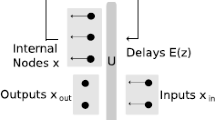Abstract
This paper focuses on a problem of network synthesis for a class of quantum stochastic systems. The systems under consideration are of triplet-type form and stem from linear quantum optics and linear quantum circuits. A new quantum network realization approach is proposed by generalizing the scattering operator from the scalar form to a unitary matrix in network components. It shows that the triplet-type quantum stochastic system can be approximated by a quantum network which consists of some one-degree-of-freedom generalized open-quantum harmonic oscillators (1DGQHOs) via series, concatenation and feedback connections.



Similar content being viewed by others
Explore related subjects
Discover the latest articles, news and stories from top researchers in related subjects.References
Miao, Z., James, M.R., Peterson, I.R.: Coherent observers for linear quantum stochastic systems. Automatica 71, 264–271 (2016)
Techakesari, O., Nurdin, H.: On the quasi-balanceable class of linear quantum stochastic systems. Syst. Control Lett. 78, 25–31 (2015)
Wang, S., James, M.R.: Quantum feedback control of linear stochastic systems with feedback-loop time delays. Automatica 52, 277–282 (2015)
Guţǎ, M., Yamamoto, N.: System identification for passive linear quantum systems. IEEE Trans. Autom. Control 61(4), 921–936 (2015)
Gardiner, C., Zoller, P.: Springer Series in Synergetics, Quantum Noise: A Handbook of Markovian and Non-Markovian Quantum Stochastic Methods with Applications to Quantum Optics, 2nd edn. Springer, Berlin (2000)
Yurke, B.S., Denker, J.S.: Quantum network theory. Phys. Rev. A 29(3), 1419–1437 (1984)
Yanagisawa, M., Kimura, H.: Transfer function approach to quantum control-part II: control concepts and applications. IEEE Trans. Autom. Control 48(12), 2121–2132 (2003)
Mabuchi, H.: Coherent-feedback quantum control with a dynamic compensator. Phys. Rev. A 78, 032323 (2008)
James, M.R., Nurdin, H.I., Petersen, I.R.: \(H^\infty \) control of linear quantum stochastic systems. IEEE Trans. Autom. Control 53, 1787–1803 (2008)
Nurdin, H.I., James, M.R., Petersen, I.R.: Coherent quantum LQG control. Autom. J. IFAC 45, 1837–1846 (2009)
Nurdin H.I.: Topics in classical and quantum linear stochastic systems. Ph.D. dissertation, The Australian National University, Canberra (2007)
Nurdin H.I., James M.R., Petersen I.R.: Quantum LQG control with quantum mechanical controllers. In: Proceedings of the 17th IFAC World Congress (2008)
Schoelkopf, R.J., Girvin, S.M.: Wiring up quantum systems. Nature 451, 664–669 (2008)
Tian, L., Carr, S.M.: Scheme for quantum teleportation between nanomechanical modes. Phys. Rev. B 74, 125314 (2006)
Nurdin, H.I., James, M.R., Doherty, A.C.: Network synthesis of linear dynamical quantum stochastic systems. SIAM J. Control Optim. 48(4), 2686–2718 (2009)
Nurdin, H.I.: Synthesis of linear quantum stochastic systems via quantum feedback networks. IEEE Trans. Autom. Control 55(4), 1008–1013 (2010)
Gough, J., James, M.R.: The series product and its application to quantum feedforward and feedback networks. IEEE Trans. Autom. Control 54(11), 2530–2544 (2009)
Gough, J., James, M.R.: Quantum feedback networks: Hamiltonian formulation. Commun. Math. Phys. 287, 1109–1132 (2009)
Davies, E.C.: One-Parameter Semigroups. Academic Press Inc., London (1980)
Author information
Authors and Affiliations
Corresponding author
Additional information
This work was supported in part by the National Natural Science Foundation of P. R. China under Grants 61273093, 61673149, and also by the National Natural Science Foundation of Zhejiang Province under Grants LZ12F03001.
Appendix
Appendix
The proof of Lemma 3
For \({\hat{R}}=(a_{jk})_{2 \times 2}\), the rank condition (17) implies that there exist vectors \({\hat{A}}\) and \({\hat{B}}\) defined in (20) such that (21) holds. Recalling (16), \({\hat{A}}=(a_1, a_2,\ldots , a_c)^T\) and \({\hat{B}}=(b_1, b_2,\ldots , b_c)^T\), we have
Substituting (21) into (37) leads to
It can be checked by \((A)^{\sharp }=(a_{ij})^*\) and \(\mathfrak {I}(A)=(A - A^\sharp )/2i\) that
Then in terms of (15), we have
On the other hand, one has by (19) and (38) that
which together with (40) proves the lemma. \(\square \)
The proof of Theorem 1
In order to compute the triplet of quantum feedback network \(G_{\text {final-net}}\) constructed in the theorem, we determine the triplet of the reduced Markov model system \(G_\mathrm{red}=(S_\mathrm{red}, L_\mathrm{red}, H_\mathrm{red})\) obtained in the theorem. With \(S, R=(R_{jk}), K=\begin{bmatrix} K_{1}&K_{2}&\ldots&K_{n}\end{bmatrix}, R_j, S_{jk}, K_{jk}, j,k \in \mathbb {N}_n\), as defined above, from (11) in Lemma 1 one can obtain each element of triplet \(G_\mathrm{red}\) known as \(S_\mathrm{red}, L_\mathrm{red}\) and \(H_\mathrm{red}\). As \(S_\mathrm{red}\) and \(L_\mathrm{red}\) are available directly in the form of (11), only \(H_\mathrm{red}\) need to be calculated further
From (10), one has that
which leads to
Expanding, recombining, and changing the order of summation gives
With \(L_{jk}=K_{jk}x_j\), and the definition of sym(A) in the theorem, one has that
Then it follows from (32) and (34) that
With the triplet \(S_\mathrm{red}=\mathrm{diag}(S_{11}, S_{22},\ldots , S_{nn}), L_\mathrm{red}=(L_{11}^T, L_{22}^T,\ldots , L_{nn}^T)^T\) and \(H_\mathrm{red}\) of \(G_\mathrm{red}\) as determined above, one can let \(G^0_\mathrm{red}=(0, 0, H_\mathrm{red})\) and \(G^j_\mathrm{red}=(S_{jj}, L_{jj}, 0)\) for \(j\in \mathbb {N}_n\). It is obvious that according to the concatenation product rule (5) \(G_\mathrm{red}=(S_\mathrm{red}, L_\mathrm{red}, H_\mathrm{red})\) can be decomposed as
Now, using the series product rules (8) and (25), one obtains that
where \(H_k=0\) for \(k \in \mathbb {N}_n\) .
Then by (36) and (41) one can compute the quantum feedback network \(G_{\text {final-net}}\) constructed in the theorem as
It is easy to see from (42) that the triplet of \(G_{\text {final-net}}\) has
that is, the triplet of \(G_{\text {final-net}}\) is equal to the triplet of \(G_\mathrm{sys}\). Therefore, according to Definition 2, \(G_{\text {final-net}}\) has realized the triplet-type quantum stochastic system \(G_\mathrm{sys}\). \(\square \)
Rights and permissions
About this article
Cite this article
Zhou, S., Fu, S. & Chen, Y. Network realization of triplet-type quantum stochastic systems. Quantum Inf Process 16, 34 (2017). https://doi.org/10.1007/s11128-016-1492-8
Received:
Accepted:
Published:
DOI: https://doi.org/10.1007/s11128-016-1492-8




